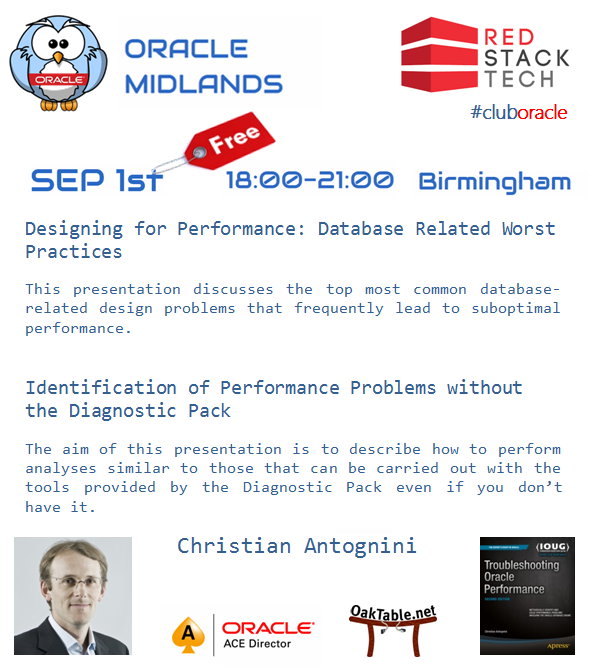 Followers of the blog will know I’ve been waiting to get access to the Oracle Cloud for a while. Well, I’ve finally got access to a bit of it. Specifically, the “Oracle Database Cloud Service” (DBaaS) part. 🙂
Followers of the blog will know I’ve been waiting to get access to the Oracle Cloud for a while. Well, I’ve finally got access to a bit of it. Specifically, the “Oracle Database Cloud Service” (DBaaS) part. 🙂
The Schema Service has been around for a few years and I had already tried that out, but IMHO it’s not really part of Oracle Cloud proper*, so I was reserving my judgement until I got the real stuff. 🙂
I’ve written a couple of articles already. Just basic stuff to document setting stuff up and connecting etc.
- Oracle Cloud : Database as a Service (DBaaS) – Create Service
- Oracle Cloud : Database as a Service (DBaaS) – Patch Service
So here are some first impressions…
Oracle Cloud : Look and Feel
Overall the cloud offering looks clean and modern. Tastes vary of course, but I like the look of it.
The navigation is a bit inconsistent between the different cloud services. It feels like the console for each section (Compute, Java, DBaaS etc.) has been written by a different team, each doing what they think works, rather than working to a single design standard. Here’s a couple of examples:
- In the “Oracle Database Cloud Service” section there is a “Consoles” button on the top-right of the screen that triggers a popup menu allowing you to switch to the Dashboard, Java Cloud and Compute Cloud console. In the “Oracle Compute Cloud” section, the “Consoles” button is not present. Instead there is a hamburger on the top-left of the screen that causes a navigation panel to slide out on the left of the screen, pushing the rest of the page contents to the right. On the top-level services page, the same hamburger produces a popup menu, kind-of like the “Consoles” button, but with the colouring of the navigation panel. I don’t find any method better or worse than the others. It would just be nice if they picked one and stuck with it, otherwise you are looking round the screen trying to decide how to make your next move. 🙂 (See Update)
- Some consoles use tabs. Some use navigation tiles. Some use both.
Don’t get me wrong, it’s not hard to navigate. It’s just inconsistent, which kind-of ruins the overall effect. If they can bring it all into line I think it will be really cool.
I think Oracle Cloud looks neater than Amazon Web Services, but the navigation is not as consistent as AWS or Azure. Having used AWS, Azure and Oracle Cloud, I feel Azure has the neatest and most consistent interface. Like I said before, tastes vary. 🙂
Probably my biggest issue with the Oracle Cloud interface is the speed, or lack of. It’s really slow and unresponsive at times. On a few occasions I thought it had died, then after about 30 seconds the screen just popped back into life. Some of the actions give no feedback until they are complete, so you don’t know if you’ve pressed the button or not.
Oracle Cloud : Ease of Use
I found DBaaS pretty simple to use. I’ve already spent some time using AWS and Azure, so there is probably some carry-over there. I pretty much completed my first pass through creation, connections and patching before I even considered looking for documentation. 🙂
The documentation is OK, but contains very few screen shots, which leads me to believe the look and feel is all in a state of flux.
I think the general Oracle Compute Cloud Service network/firewall setup is really quite clear, but you can’t edit existing rules. Once a rule is created you can only enable, disable or delete it. I found myself having to delete and create rules a number of times when it felt more obvious to let me edit an existing rule. I’ll mention a DBaaS issue related to this later.
One slight concern is I’m not sure how I will feel about the firewall screens once I have lots of rules, because each rule takes up a lot of screen room. There is a search, so I guess it pays to be very disciplined with the names of rules.
DBaaS Specifically
Just some general observations about the DBaaS offering.
- The “Oracle Database Cloud Service” DBaaS offering looks OK , but I noticed they don’t have multiplexed redo logs. I never run without multiplexed redo logs, regardless of the redundancy on the storage layer. Even if they were all shoved in the same directory, it would still be better than running without multiplexed files. This is a bit of mandatory configuration the user is left to do after the fact.
- The DBaaS virtual machine has Glassfish and ORDS installed on it, which is necessary because of the way they have organised the administration of the service, but it’s not something I would normally recommend. Databases and App Servers never go on the same box. Like I said, I understand why, but I don’t like it.
- The management of the DBaaS offering feels fragmented. For some administration tasks you use the main cloud interface. For others you jump across to the DBaaS Monitor, which has a completely different look and feel. For others you to jump across to [DBConsole – 11g | DB Express -12c]. For a DBaaS offering, I think this is a mistake. It should all be incorporated into the central console and feel seamless. I understand that may be a pain and repetition of existing functionality, but it feels wrong without it.
- I found the network/firewall setup done by the DBaaS service to be quite irritating. It creates a bunch of rules for each DBaaS service, which are all disabled by default (a good thing), but all the rules are “public”, which you would be pretty crazy to enable. Because you can’t edit them, they end up being pretty much useless. It really is one of those, “Do it properly or don’t bother!”, issues to me. If the DBaaS setup screens asked you to define a Security IP List, or pick an existing one, and decide which services you wanted to make available, it could build all these predefined rules properly in the first place. Alternatively, provide a DBaaS network setup wizard or just don’t bother. It feels so half-baked. 🙁
- Dealing with the last two points collectively, the fragmentation of the management interface means some of the management functionality (DBaaS Monitor and [DBConsole – 11g | DB Express -12c]) is not available until you open the firewall for it. This kind-of highlights my point about the fragmentation. I’m logged into the DBaaS console where I can create and delete the whole service, but I can’t use some of the management features. It just feels wrong to me. It is totally down to the implementation choices. I would not have chosen this path.
- Unlike the AWS RDS for Oracle, you get complete access to the OS and database. You even get sudo access to run root commands. At first I thought this was going to be a good thing and a nice differentiator compared to RDS, but having used the service I’m starting to think it is a bad move. The whole point of a DBaaS offering is it hides some of the nuts and bolts from you. I should not be worrying about the OS. I should not be worrying about the basic Oracle setup. Giving this level of access raises more questions/problems than it solves. I feel I should either do everything myself, or pick a DBaaS offering, accept the restrictions of it, and have it all done for me. The current offering feels like it has not decided what it wants to be yet.
- When I patched the database through the service admin console it worked fine, but it took a “really” long time! I waited quite a while, went out to the gym and it was still going when I came back. Eventually I started an SSH session to try and find out what was happening. It turns out it took over 2 hours to “download” the PSU to the VM. Once the download was complete, the application of the patch was done quickly. Interesting.
- The “Oracle Database Cloud Service – Virtual Image” option seems pretty pointless to me. On the website and console it says there is a software installation present, but this is not the case. Instead, there is a tarball containing the software (/scratch/db12102_bits.tar.gz). It also doesn’t come with the storage to do the actual installation on, or to hold the datafiles. To do the installation, you would need to “Up Scale” the service to add the storage, then do the installation manually. This process is actually more complicated than provisioning a compute node and doing everything yourself. I think Oracle need to ditch this option and just stick with DBaaS or Compute, like Amazon have done (RDS or EC2).
Conclusion
I like the Oracle Cloud more than I thought I would. I think it looks quite nice and if someone told me I had to use it as a general Infrastructure as a Service (IaaS) portal I would be fine with that.
I like the DBaaS offering less than I hoped I would. I feel quite bad about saying it, but it feels like a work in progress and not something I would want use at this point. If it were my decision, I would be pushing the DBaaS offering more in the direction of AWS RDS for Oracle. As I said before, the current DBaaS offering feels like it has not decided what it wants to be yet. It needs to be much more hands-off, with a more consistent, centralized interface.
I don’t have full access to the straight Compute Cloud yet, so I can’t try provisioning a VM and doing everything myself. If I get access I will try it, but I would expect it to be the same as what I’ve done for EC2 and Azure. A VM is a VM… 🙂
When I read this back it sounds kind-of negative, but I think all the things I’ve mentioned could be “fixed” relatively quickly. Also, this is only one person’s opinion on one specific service. The haters need to try this for themselves before they hate. 🙂
Cheers
Tim…
* Just to clarify, I am not saying the Schema Service isn’t “Cloud” and I’m not saying it doesn’t work. I’m just saying I don’t see this as part of Oracle’s grand cloud database vision. It always seemed like a cynical push to market to allow them to say, “we have a cloud DB”. If it had been branded “APEX Service” I might have a different opinion. It is after all a paid for version of apex.oracle.com. This is a very different proposition to promoting it as a “Cloud Database”.
Update: Since I wrote the post, the navigation for the “Oracle Database Cloud Service” section has been amended to match that of the “Java Cloud Service” and the top-level “Services” section, so only the “Compute Cloud Service” section has different navigation. Much better!
 As always, installations of Oracle server products on Fedora are not a great idea, as explained here.
As always, installations of Oracle server products on Fedora are not a great idea, as explained here.
 I wrote a few months ago about having a play with Windows 10 (
I wrote a few months ago about having a play with Windows 10 (

 KeePass
KeePass